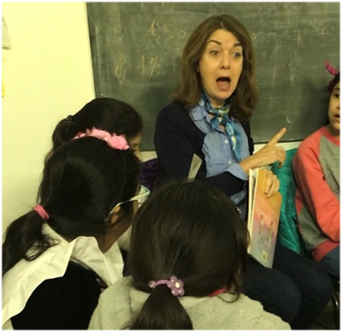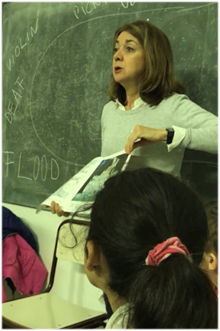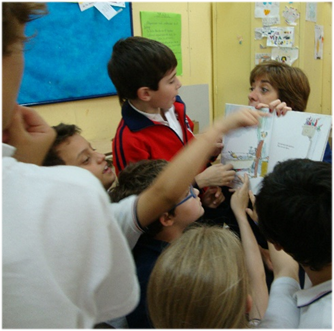Interactive Storytelling in ELT – Why and How?
Mercedes Pérez Berbain is an educational consultant and a teacher trainer at OUP, ESSARP, and Pilgrims TT. She holds an MA in Education with Distinction from Oxford Brookes University, UK. She has written teaching materials for Pearson and OUP, and has recently co-edited a volume for Palgrave Macmillan called International Perspectives on Diversity in ELT (2021). Her research interests include leadership in education, inclusion, and young learners.

Abstract
This article argues that English language learners need opportunities to engage in conversation in order to develop thinking and language competencies. One way of catering for those needs is through interactive storytelling. At first, conversation is defined and discussed in the ELT context. This is followed by a description of storytelling as a way of interacting in conversation. Then, there is an account of how storytelling can be further approached to help learners continue developing linguistic and non-linguistic competencies to become storytellers themselves. The final section includes classroom ideas to carry out with young learners, which can be easily adapted to older learners.
Conversation in English language teaching (ELT)
Conversation is a basic human activity, which most of us engage in on a daily basis. Conversation is interactive, interpersonal, and invites everybody to take part in their own way. With the advent of new technologies, we have expanded our ways of interacting with others. As language teachers we place conversation in its many guises centre-stage, since we know that language development – our own and our learners’ – evolves from conversations (Hatch, 1978; van Lier, 1996). Furthermore, from a sociocultural perspective, “conversation is the medium for all learning”, not just language learning (Thornbury & Slade, 2006, p. 2). It is in conversation that relationships and social competencies are developed, as well as intercultural ones (Beacon, 2021). Through this lens, effective teaching is essentially sustained conversation (Mercer, 1995). The question we educators may need to ask, among other key questions, is the extent to which classroom talk is dialogic and how that can be implemented.
Interactive storytelling
If viewed as interactive and not transactional, storytelling may be one versatile way of engaging in conversation. Storytelling is a practice which brings us back to days immemorial, when stories were passed on by word of mouth from generation to generation to tell human matters of popular concern. Stories – from the Greek word eidenai, which means ‘to know’– are told to understand and give meaning to our lives. In fact, Bruner states that “stories provide models of the world” (2002, p. 25). Stories are said to be mirrors, windows and sliding doors. Windows which allow us to know more about the world, sliding glass doors which invite us to imagine being in that world, and mirrors which help us reflect on our inner worlds (Bishop, 1990). In what I call transactional storytelling the teacher delivers the story – the more professional the better – and learners construct their story individually. In interactive storytelling, however, the teacher and the learners, as speakers and readers of English, approach the story off the cuff. As the pictures below illustrate, teachers and learners voice their thoughts as the story unfolds, making audible many learning strategies as they do so. They learn in a conversational storytelling experience.



Learners voicing their thoughts
Neither interactive, nor transactional storytelling are oral versions of a written story, nor are they read-alouds. Like conversation, interactive storytelling is co-constructed and contingent i.e., it depends on what the people present bring to the story. This view of storytelling is spontaneous; it cannot be planned. English language teachers are in an ideal position to make conversation through storytelling because they know how to adjust their language for learners to build the plot and contribute with their own responses (Mourão, 2016). Moreover, teachers know when and how to include a new term or idea and they also know the strategies which are involved in reading (Miglino, 2018), interacting (Thornbury & Slade, 2006), and learning (Claxton, 2021). They also know that these strategies are learnt when they are consistently practised.
How to tell stories
There is no best way to tell a story. It simply invites learners to engage in conversation with the story, their fellow story-builders, and themselves. The experience often results in the development of thinking, and language (Mourão, 2015). Teachers may use a picturebook to tell the story orally. They create suspense at the start by asking learners to hypothesise from the title, the covers, and endpapers. It is the learners who build the story. The teacher as storyteller is the guide. Illustrations trigger many ideas and teachers pause at the right moments to help learners to weave in their thoughts and make sense. Meaning is co-constructed. Teachers may read and dramatise some parts of the story but most of it is simply told in the teachers’ own words, using abundant gestures, a variety of tones of voices, onomatopoeic sounds, and questions which foster imagination and open up possibilities. When the story ends, learners respond to it in diverse ways since stories say different things to different people. Children may draw, or dramatise their responses, or choose from a menu of ideas, since they may not be able to verbalise their responses yet.
Telling the story in an interactive way, adjusting the language to the linguistic level of the learners, and teaching for learners’ creative responses and developed intercultural and inclusive competencies (Beacon, 2021) are all rich teaching strategies themselves. Yet, as language teachers we want to ensure that learners develop language and thinking competencies as well. What follows is how storytelling can be approached to help children develop interaction (CEFR, 2018), learn key vocabulary and ideas from the story, and tell the story in their own words, prior to engaging in an intercultural project, for instance.
The development of language and thinking competencies
Revisiting the key ideas in the story actively through a variety of games and tasks provides learners with the possibility of developing language competencies such as interaction, and thinking competencies, such as structuring. For instance, through a game in which children decide if an idea about the story is true or false, or if the idea corresponds to the beginning, the middle, or the end of the story, learners are cognitively active, recognising key ideas from the story and acting upon them to play the game. Yet, they feel no linguistic pressure to tell the story. Children first need to actively listen and read before they are ready to speak and write. Examples of activities which offer this possibility are: put in order, match, sort out, mind-map, draw, or engage in any artistic creation from key ideas in the story.
And then speaking starts
Then come tasks which invite learners to voice ideas from the story in preparation to telling the story on their own. For instance, given one or two key words or pictures, learners say the idea in the story, e.g., from ‘cake’ and ‘wolf’ in the story Little Red Riding Hood, learners can say: “Little Red Riding Hood tells the wolf she is taking cake to her grandmother because she is ill”, or “The wolf knows Little Red Riding Hood’s grandmother is ill so he hurries up”, or “Little Red Riding Hood is carrying cake for her grandmother and she told the wolf her grandma is ill”, or “Little Red Riding Hood has cake in her basket and the wolf is mean”, or “The wolf sees the cake and runs fast. Little Red Riding Hood is late”. The grammatical possibilities are endless, yet, the idea is pretty much the same. Each learner voices their idea within their own linguistic ability. This game, among others, fosters the development of speaking. It prepares learners to word ideas.
Learners as storytellers
As a final step, learners tell the story in their own words, often collectively, so that they each tell one part of the story. It is not unusual for learners to say at this last stage, “I don’t remember the story”. This is because they think they have to tell the story just as they once heard it, or just as it was written by the author. On hearing that I found myself saying, “There’s no need to remember the story. Just invent it”, which actually means, “tell the story in your own words”. At once, learners feel they can do that. They tend to use all key words appropriately and link them according to their linguistic mastery. This final stage of being storytellers seals, in many ways, the learning process because it gives children the possibility to feel what it is like to be a speaker. Many competencies will be at stake and will find their way through the challenge, such as, looking at the people in the audience in the eye, managing their voice, making appropriate gestures and pauses, and sustaining the audience engagement through their speaking. Abstract ideas which were once lifted and accommodated from the storyteller’s discourse are now reaching out in the shape of the learners’ own speech. Each learner tells their own version of the story; and as we know, there are as many versions of the same story as there are people.
The table below (Table 1) includes various activities to be carried out at the different stages of the learning cycle. Yes, it is e-a-s-y and there is nothing new under the sun. Yet, there is great value in offering learners the chance to engage in those language and thinking activities on the story itself, if we want to help them to develop their linguistic and thinking competencies. Parallel to these four stages of interacting with the story, becoming aware of the different moments in the story and various ways of wording them, voicing the ideas in the story, and telling the story in their own words, learners can engage in project work to explore an interest the story may have triggered (Boss & Larmer, 2018; Lev, Clark, & Starkey, 2020). It is only when learners use language to find out and make something of their choice that they can be said to be included in education, bringing their diverse backgrounds, experiences, and perceptions on board.
Table 1. Activities at different stages of language and thinking development.
|
Teaching cycle |
Activities |
|
Exposing learners to stories orally and interactively. Learners build the story. |
|
|
Awareness is raised of the different moments in the story and how they are expressed. |
|
|
Say the idea |
|
|
Yes, learners can tell the story in their own words |
|
References
Beacon, G. (2021, November 13). Inclusive English language classrooms: promoting children’s anti-biased attitudes through picturebooks. IATEFL, YLTSIG, https://www.youtube.com/watch?v=5XNTd7sBY1U
Bishop, R. S. (1990). Mirrors, windows, and sliding glass doors. Perspectives: Choosing and using books for the classroom, 6(3).
Boss, S. with Larmer, J. (2018). Project based teaching. ASCD. Kindle.
Bruner, J. (2002). Making stories. Harvard University Press.
Claxton, G. (2021). The future of teaching: And the myths that hold it back. Routledge.
Council of Europe (2018). Common European Framework of Reference for Languages: Learning, teaching, assessment. Companion volume with new descriptors.
Hatch, E. (1978). Discourse analysis and second language acquisition. In E. Hatch (Ed.), Second language acquisition. Newbury House.
Lev, S., Clark, A. and Starkey, E. (2020). Implementing project based learning in early
childhood. Routledge.
Mercer, N. (1995). The guided construction of knowledge: Talk amongst teachers and learners. Multilingual Matters.
Miglino, V. (2018). Reading comprehension strategies: The neglected tools. An experience with EFL students in a South American country. HLT, 20 (6).
Mourão, S. (2015), Fostering affective responses to picturebooks in the young learner classroom, HLT 17(4).
Mourão, S. (2016). Picturebooks in the primary EFL classroom: Authentic literature for an authentic response. CLELE journal, 4(1), 25 – 43.
Thornbury, S. & Slade, D. (2006). Conversation: from description to pedagogy. CUP.
van Lier, L. (1996). Interaction in the language curriculum: Awareness, autonomy, and authenticity. Routledge.
Please check the Pilgrims f2f courses at Pilgrims website.
Please check the Pilgrims online courses at Pilgrims website.
Interactive Storytelling in ELT – Why and How?
Mercedes Pérez Berbain, ArgentinaMediation and Young Learners
Tanja Marzidovšek, Slovenia